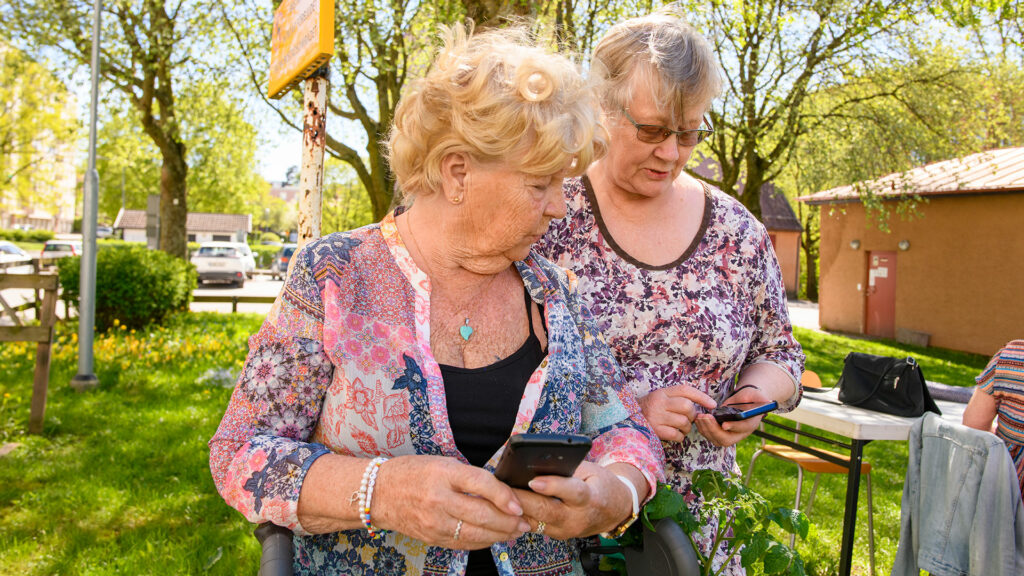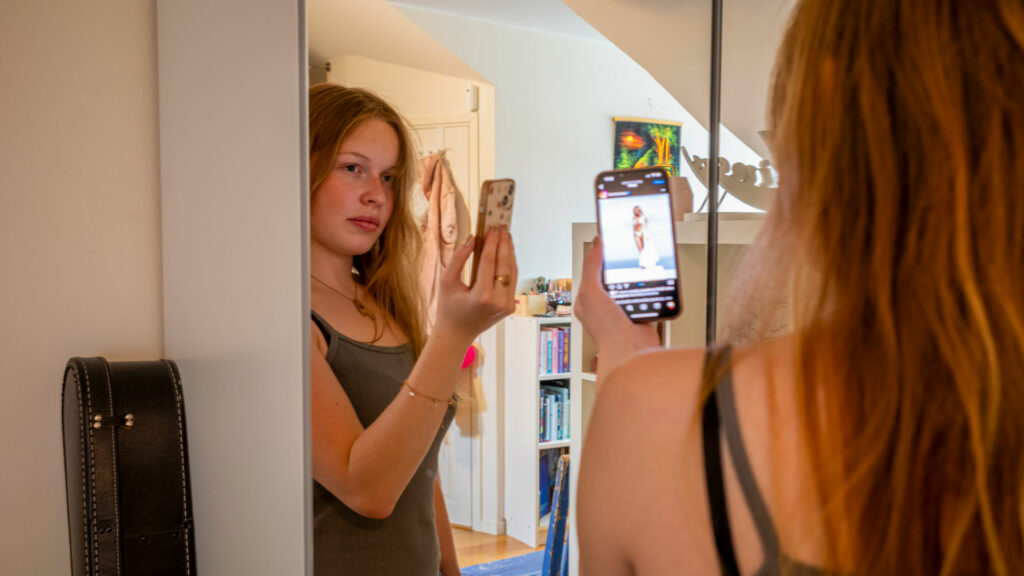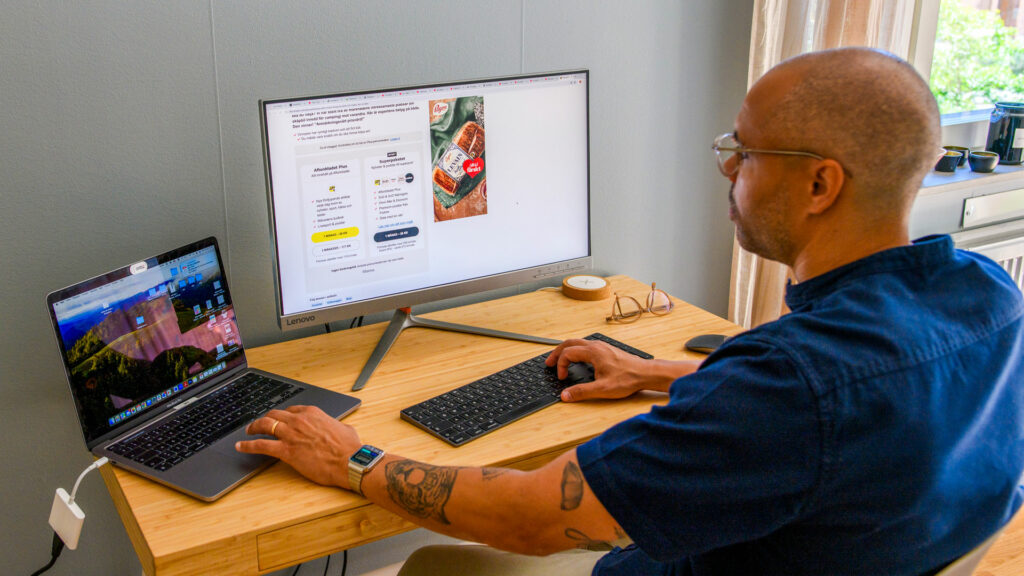Summary
English
One in five Swedes needs assistance with digital issues. Social media gives us tips and advice but makes some of us feel bad – especially young women. Almost everyone thinks the police should be allowed to monitor our private online conversations. This is digital Sweden in 2024.
A unique survey of digital Sweden
Welcome to The Swedes and the Internet 2024, a unique survey of Swedes’ online lives. With this report, The Swedish Internet Foundation wants to offer facts and insights about internet use in Sweden. We want to contribute objective knowledge about how digitalisation affects society and the individual.
The Swedish Internet Foundation works towards an internet that makes a positive contribution to people and society. Our vision is that everyone in Sweden wants to, dares to and is able to use the internet.

This summary provides a quick overview of the report and the key insights from each chapter, with brand-new information about internet use in Sweden, digital services, social media, online surveillance, online hate and news consumption.
We hope you will find this year's report useful!
Chapter 1: Internet usage
In this chapter, we report on how many Swedes use the internet and investigate how internet usage has evolved. We also look closer at how many people are online every day versus those who use it less often, so-called infrequent users. Additionally, we investigate how many people need assistance with online activities and if the need for digital assistance differs between those of working age, 18–64 years old, and those of retirement age, 65 years or older.
Internet usage has neither increased nor decreased in 2024
Almost all Swedes – as much as 95% – use the internet, and nearly as many are online every day. The number of internet users in Sweden is at the same level as the previous year 2023. Age is the factor that has the biggest impact on internet use, and among those who are 16–64 years old, everyone – 100 percent – reports that they use the internet.
Older women are among the lowest proportion of internet users
Generally speaking, all Swedes who do not use the internet are of retirement age. One in five people of retirement age report that they do not use the internet, but there is a big difference between younger and older pensioners. The proportion of non-users is more than five times higher among older pensioners over 75 years old compared to younger pensioners 65–75 years old. After the age of 75, significantly more women than men do not use the internet.

One in ten Swedes of working age need digital assistance
One in five Swedes who are 18 years or older states they need assistance with online activities. Among those of working age, 18–64 years old, a little more than one in ten needs digital assistance, mainly with technical problems they cannot solve on their own. Other challenges the working population need assistance with are understanding technical terms, finding the correct search phrases, transferring information from an old to a new device, installing mobile BankID and dealing with security questions, parking apps, passwords and changes after updates.
The need for digital assistance quadruples in retirement age
Compared to one in ten people of working age, 18–64 years old, the need for online assistance more than triples among younger pensioners, 65–75 years old, and then increases fivefold among the oldest, those over 75. Among internet users of retirement age, the overall need for digital assistance is four times greater than that of the younger population.
Apart from the fact that many more older people need digital assistance, the types of needs are similar between the younger and older populations. However, it is more common for those of retirement age to express difficulty in understanding English terminology and to need assistance paying bills and shopping online. Older people are also more concerned and worried of making mistakes and "causing problems".
The "pre-digital generation" needs assistance with most things online
The oldest pensioners over 75 years old say that they need assistance with most or all online activities, and above all, this applies to women. They describe themselves as belonging to the "pre-digital generation" who have found it difficult to keep up with developments, especially after retirement.
Some of the main reasons for the older population’s greater need for digital assistance are that they find it difficult to stay up-to-date on what digital possibilities are available to them and to know where and from whom they can get assistance. They experience technical development progressing too quickly, and one 87-year-old man describes it as no longer feeling like he is the "boss of his own computer".
Chapter 2: E-services
In this chapter, we examine how the use of digital mailboxes has evolved over the past year. Furthermore, we follow up on how many people have e-identification and, above all, we look closer at the use of mobile Bank ID. We also find out how many people have activated a digital ID card with a photograph – and how many people know they can do this. We then give answers to how many Swedes pay using an app and how many swish or tap their mobile phone in a physical shop.
The digital mailbox Kivra continues to grow in 2024
7 out of 10 Swedes will have a digital mailbox in 2024. If we look back a couple of years, we see slow growth. The use of digital mailboxes is increasing both among pensioners and young adults. Like the majority of the population, most of them have chosen Kivra. Two-thirds of Swedes use Kivra, making the service the dominant player among digital mailboxes. Kivra is also the only digital mailbox that is growing in 2024.

Nearly everyone uses Bank ID
Nearly all Swedes use e-identification, and the number of users has not increased or decreased since 2023. Mobile Bank ID is the dominant service on the market, and 92 percent of Swedes use it. Via their Bank ID, one in five Swedes will activate a digital ID card with a photograph in 2024. Well above half – 61 percent – do, however, know about this service introduced in 2023.
Swish is number one among payment apps
The majority of Swedes use an app or digital service for payments. By far, the most used app is Swish. Compared to 2021, Swish has increased its share of users and is now used by nearly 9 out of 10 Swedes. Far behind, in second place, is Apple Pay, which is not even used by one in four Swedes. Apple Pay is the most popular among those born in the 2000s.
Many youngsters pay by tapping their mobile phone
When paying in physical shops, just over 5 out of 10 Swedes have used Swish, and slightly fewer – just under 4 out of 10 – have tapped their mobile phone, that is, have used an electronic wallet. On the other hand, when it comes to how people usually pay in physical shops, nearly one in five say they tap their mobile phone, and nearly no one uses Swish. Tapping the mobile phone is a payment method that is more popular among youngsters and in cities.
The population over 65 risks being excluded from digital society
Age is the factor that has the greatest impact on the use of e-services which is related to internet use. If we compare the working-age population, 18–64 years old, with those of retirement age over 65, we see a significant difference in use, and it is the older population who are at risk of being excluded from digital society.
For example, only 1 percent of those aged 18 to 64 do not have e-identification, compared to 25 percent among those of retirement age. Although the difference is big between younger and older pensioners, we already see that among younger pensioners aged 65–75 years, 9 percent do not have e-identification, compared to 44 percent among those over 75. We see the same pattern for other e-services we examine in this chapter.
Chapter 3: Social Media
In this chapter, we show the number of people using social media, which services are used and whether these have increased or decreased during the period between 2021 and 2024. We also examine the advantages and disadvantages that Swedes experience using social media. For example, how many think that it expands their social circle? And who feels less attractive because they compare their appearance to others on social media?

The chapter also shows which social media children and youths use. We explore how many children and youngsters have social media accounts that their parents are unaware of, how many have posted a TikTok trend, and who is writing with people they do not know. Last but not least, how usual is it that children and youths feel left out when they see where others are on the so-called Snap Map?
The growth rate of social media is slowing down
In 2024, there is a wide range of social media and Swedes use many different platforms parallel to each other. Almost all internet users today use social media, and the platforms used mostly stay the same from year to year.
However, there are some shifts in the use of different social media platforms when looking at specific target groups. Not least, among young people who are both adopting new platforms and stopping using previously popular platforms.
Facebook is used less frequently
Facebook is still one of the most popular platforms, reaching users across all generations. The total share of users during the period between 2021 and 2024 has been largely stable, with the exception of a small decrease in 2023. On the other hand, daily use has steadily declined over the last four years, which suggests that Facebook is being used less frequently over time.
The difficulty for new social media platforms to establish themselves in the market
In this years’ survey, four new social media platforms are measured; Threads, Bluesky, Yubo and Mastodon. Mastodon and Yubo were also included in the 2023 survey, while Threads and Bluesky are brand new for this year. However the number of people who have tested some of these platforms is quite small.
Threads is the most successful platform for attracting new users. One possible explanation is that the app is owned by Meta and people can log into Threads with their existing Instagram account, a service that already has many users.
However, the platforms Bluesky, Yubo and Mastodon barely reach 1 percent of Swedes during the year.
- Bluesky reaches the widest target group during the year with 1 percent of users among those born in the 1970s, 1980s and 1990s.
- During the year, Yubo reaches 1 percent of those born in the 2000s.
- During the year, Mastodon is used by 1 percent of those born in the 1970s.
Social media makes Swedes’ social lives easier
Many Swedes believe that social media is beneficial to their social life. Social media makes it easier to communicate with existing contacts and, for many, also expands their social circle. More than one in four also use social media to get support and advice in various interest groups. This can be anything from tips about hobbies, leisure interests or house projects to getting support from others with experience of specific illnesses or mental health.
Young women are affected the most by the drawbacks of social media
Young women are particularly hard hit by the disadvantages of social media – to a much greater extent than men of the same age. This is mainly about young women’s experience of wasting too much time on social media and feeling less attractive because they often compare their appearance with others. It is also not unusual among younger women to feel alone or excluded when they see other people’s posts and pictures or to feel that they are a failure when they compare themselves with others on social media.
Chapter 4: National news online
In this chapter, we explore how many people follow nationwide news outlets on social media platforms. The chapter presents which news media outlets are most commonly followed on social media and how this varies between gender, age and political view. We also find out if social media encourages us to read more national news, which we may not otherwise have been aware of.

In the chapter, we also investigate who has actively engaged during the year to ensure the accuracy of national news and how many people access national news through a paid outlet.
More than half of Swedes follow nationwide news outlets on social media platforms
It is common among Swedes of most generations to follow news media outlets for national news. This is most common among people born in the 1950s and the 1990s, with more than half of these people being followers. However, even among the oldest internet users (born in the 1920s, 1930s and 1940s) and the very youngest (born in the 2000s and 2010s), more than 4 out of 10 follow news outlets on social media platforms.
Political preferences affect the choice to follow SVT News on social media
The choice of national news outlets Swedes follow on social media varies somewhat between different generations, while the difference between men and women is generally small. However, people with different political views choose different news outlets to a large extent. These differences are particularly apparent when it comes to Public Service. People who are clearly to the left of the political spectrum are significantly more likely to follow SVT News and Sweden’s National Radio compared to people who are clearly to the right.
Social media enables Swedes to access more national news
Nearly half of Swedes access national news through social media that they would not have otherwise learned about. Social media is particularly important for the younger generations. Almost two-thirds of those born in the 2000s and 2010s say that social media enables them to access more national news.
Young adults are more likely than older people to verify the accuracy of national news they read online
Age plays an important role when it comes to questions about source trustworthiness online. In this year’s survey, we asked, among other things, how many people have double-checked the accuracy of national news and if they have checked the source or publisher of a national story during the past year.
People born in the 1980s or 1990s have taken the most action. Also, those born in the 2000s and 2010s are more likely than others to actively verify the truth of a national news story online. The number then drops gradually with age.
Many Swedes only choose free national news outlets
Just over 6 out of 10 Swedes only use free news outlets for national news. Pensioners, low-income earners and people with completed primary or secondary education are more likely to use free news outlets. However, even among average and high-income households, a majority choose to only use free news outlets.
A small number of Swedes have access to paid news outlets via their employer
A small group of Swedes, 3 percent, access paid news outlets for national news via their employer. This corresponds to around 5 percent of employees, with a higher proportion among white-collar workers (7%) compared to people with blue-collar occupations (2%).
Chapter 5: Online hate
In this chapter, we find out how many Swedes have been affected by online hate, abuse or negative comments. We also investigate how online hate has developed over the period between 2021 and 2024, both for the population as a whole and specifically for young people aged 12–19 years old. In addition, we look closely at how many Swedes have seen politicians and elected representatives be exposed to online hate and we allow the interviewees to describe in their own words the hate they have seen or read online.
More men than women affected by online hate
In 2024 more than 7% of Swedes aged 12 or older would have been affected by online hate. Online hate has nearly doubled since 2021, when it was at 4 percent, but it has been at the same level over the past three years. Young people are more often targeted than the elderly and nearly twice as many men as women have been affected by online hate this year. People with disabilities or different abilities are also affected by online hate to a significantly greater extent than the general population.

Young people are especially exposed to online hate
More than any other age group, young people aged 12–19 are most affected by online hate, abuse or negative comments on the internet. Online hate is increasing among teenage boys and in high schools. In 2024, one in five young people – 20 percent – have been subjected to online hate. Nearly one in four teenage boys are affected as well as one in six teenage girls.
Among those who are clearly on the political right, twice as many men than women are affected by online hate
Nearly one in ten – 9 percent – of those who are clearly on the political left and 8 percent of those clearly on the right have been affected by online hate. Men and women who are clearly on the left are affected to an equal extent. Among men and women who are clearly on the right, one in ten men and one in 20 women are affected. So, there are twice as many men than women clearly on the right who are affected by online hate.
Just over half of young people at high school have seen politicians exposed to online hate
As many as 44 percent of Swedes have seen politicians and elected representatives exposed to online hate in 2024. More men than women have witnessed this and it is most common among young adults between 20–34 years old.
Among young people aged 12–19, nearly 4 out of 10 have seen politicians exposed to online hate, most commonly at high school where almost half have witnessed online hate against politicians. More than twice as many young people have witnessed online hate against politicians compared to older internet users aged 75 years or over.
Half of all women clearly on the left have seen politicians affected by online hate
Half of those who are clearly on the left politically and nearly half of those clearly on the right have seen politicians affected by online hate, which is more compared to the Swedish population in general. It is split evenly among men where 51 percent have witnessed online hate against politicians. Compared with the general population, more women clearly on the left – 50 percent – have seen politicians exposed to online hate than women clearly on the right – 44 percent – showing little difference.
"Hatred, threats, provocation and mockery"
Swedes talk about online comment fields filled with personal attacks and actual death threats against politicians. They describe organised groups of internet trolls that incite and provoke, hoping people are not critical of the source and buy into their lies. Many experience that online hate against politicians seems to be getting worse and that, alarmingly, it risks becoming normalised as it increasingly starts to become an "everyday occurrence". Many point out that they lack factual discussions and openness. Some even express that online hate against politicians is a threat to democracy.
Chapter 6: Monitoring online
In this chapter, we follow up on what Swedish internet users see as digital monitoring compared with 2023. We explore attitudes towards camera surveillance with face recognition in public places and also opinions about whether police should have access to private online conversations. Should this be allowed to make the fight against crime easier, or should it be forbidden to protect personal privacy?

We also investigate if those clearly on the political left or right differ in their attitudes about surveillance. In addition, we investigate how many believe that their mobile phones are eavesdropping on them, leading to getting advertisements based on things they have earlier talked about.
Swedes want camera surveillance in the fight against crime
The majority of Swedes want camera surveillance with facial recognition in public places to assist with crime prevention. Only 2 out of 10 think that it should be forbidden to protect the privacy of citizens. Young people are significantly more sceptical about camera surveillance than older people, in particular young men between 20 to 34 years old. These results are consistent with last year, 2023.
Those clearly on the political left are less accepting of online surveillance
Among those who identify clearly with the political left or right, opinions differ regarding camera surveillance in public places for crime prevention. More than twice as many people clearly on the left want to see a ban compared to those clearly on the right. Among men clearly on the political left, there are even more who want to see a ban against camera surveillance than those who think it should be allowed.
Swedes want the police to have access to private online conversations when there is a suspicion of crime
9 out of 10 Swedes think the police should have the right to access private online conversations in cases of suspected crime. 5 out of 10 say that this should apply to all crimes, and just over 4 out of 10 think that it should only apply to serious crimes. Only 4 percent think that it is more important to protect citizens’ personal privacy, which is particularly important to young men. The differences in the result compared to 2023 are small.
Those clearly on the political right are more positive to letting the police access private online conversations
The majority of those who are clearly on the political left or right think that the police should have the right to access private online conversations in cases of suspected crime. However, there are somewhat more people clearly on the right who are supportive, and the majority of them say that it should apply to all crimes, unlike those clearly on the left. Regarding protecting personal privacy, more people clearly on the left think it is more important, particularly men who identify as being clearly on the left.
The majority of Swedes believe that their mobile phones eavesdrop on them
A clear majority – 63 percent – believe that their mobile phones are eavesdropping. The reason they believe this is that advertisements show up on their mobile phone about something they have talked about earlier. Older people are less inclined to believe that their mobile phone is eavesdropping on them than younger people. Only 1 out of 4 pensioners who use the internet believe that their mobile phone eavesdrops compared to 3 out of 4 of those under 65 years old. More women than men believe that the mobile phone is listening to them.
